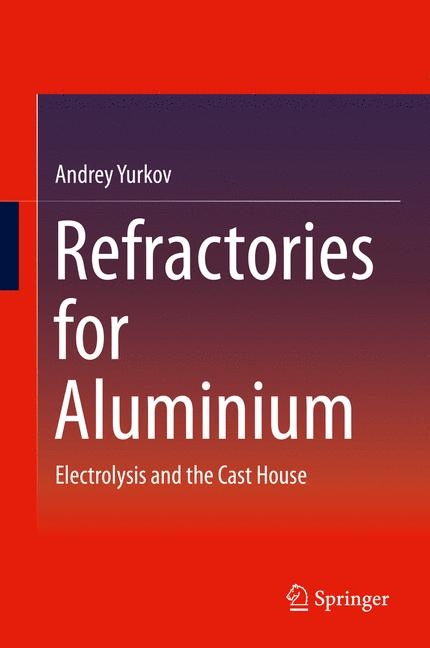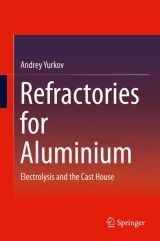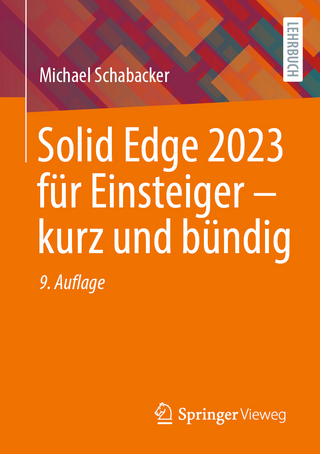Refractories for Aluminium
Springer International Publishing (Verlag)
978-3-319-11441-5 (ISBN)
- Titel erscheint in neuer Auflage
- Artikel merken
Andrey Yurkov, graduated from Moscow Mendeleev University of chemical technology, department of ceramics and refractories. He holds a Ph.D. in structural ceramics and Dr. Sci. Degree in materials science of refractory materials. Yurkov has more than a 100 publications. His areas of expertise and interests include materials science and processing of non-oxygen and oxygen containing ceramics and refractories, and their applications in the Aluminium industry Yurkov is currently working for the company “Russian Aluminium (RUSAL). He has also served as the organizer and chairperson of the seminar and conference “Refractories and carbon cathode materials for Aluminium industry”.
Preface Glossary 1. The properties of refractory and heat insulation materials 1.1 Classification. Some words about quality control 1.2 Density, porosity and related characteristics. The types of porosity. 1.3 Mechanical characteristics 1.4 Thermo mechanical characteristics 1.5 Thermal conductivity and related characteristics 1.6 Thermal expansion, thermal strains and thermal shock resistance 1.7 Corrosion resistance 2 Refractories and carbon cathode materials for aluminium reduction cells 2.1 Reduction of aluminium. Elements of reduction technology. The main controlled parameters of reduction (electrolysis). Elements of energy balance and heat balance of reduction cell. Reduction shop. Types of reduction cells 2.2 Lining of reduction cells. The pre heating, the start up and operation. Retrofit of cells and tendencies. The mains causes of failures. Dry autopsies. 2.3 Cathode carbon bottom blocks. 2.3.1 Types and properties. 2.3.2 Elements of technology, raw materials and processing 2.3.3 Defects in carbon cathode blocks 2.3.4 Testing and characterization 2.3.5 Some words on grades of carbon cathode blocks 2.3.6 Some words on structure of carbon cathode blocks in connection with grain size composition, sintering and pore size structure 2.3.7 Interaction of carbon cathode blocks with the steel shell and the collector bars. Cracks, induced by thermal strains and thermal shock 2.3.8 Interaction of carbon cathode blocks with electrolyte during the start up and in service. Wear. Infiltration 2.3.9 Carbon ramming paste. Testing. Installation. 2.4 Coatings of carbon cathode blocks and new cathode materials. Drained cathode 2.5 Side lining. Carbon side lining. Implementation of Silicon Carbide side lining. Alternative materials. Elements of technology of Nitride bonded Silicon Carbide. Changes in SiC lining in the service and the mechanisms of decay. Corrosion resistance and testing. 2.5.1 Silicon Carbide castables, mortars and ramming mixes for installation of SiC blocks 2.6 Refractory barrier materials for cathode. Dry Barrier Mixes and bricks. Properties and chemical resistance. The processes during service. Interactions with infiltrated electrolyte. Change of properties. Lenses. 2.7 Heat insulation materials. Types and properties. Elements of technology. The processes during service. Interactions, change of properties 3 Refractories and heat insulation materials for the cast house. 3.1 Cast house 3.2 3.2 Physical and chemical interaction of refractories with aluminium and aluminium alloys 3.3 Refractories for melting and holding furnaces of the cast house 3.4 The elements of lining design 3.5 Holding and melting furnaces. 3.6 Induction furnaces and ladles 3.7 Launders (runners) and casting equipment. Elimination of asbestos containing materials 4 Refractories for the anode baking furnaces .The processes during service. Interactions.
| Zusatzinfo | XIII, 254 p. 144 illus., 56 illus. in color. |
|---|---|
| Verlagsort | Cham |
| Sprache | englisch |
| Maße | 155 x 235 mm |
| Gewicht | 584 g |
| Themenwelt | Technik ► Maschinenbau |
| Schlagworte | Aluminum • Aluminum Reduction Cell • Anode Baking Furnaces • Calcining Furnaces • Carbon Cathode Blocks • Cast House • Corrosion Resistance in Refractories • Corrosion Tests • Heat Insulation Materials • Holding and Melting Furnaces • Reduction Cells • Refractories For Aluminum • Refractory materials • thermal conductivity |
| ISBN-10 | 3-319-11441-7 / 3319114417 |
| ISBN-13 | 978-3-319-11441-5 / 9783319114415 |
| Zustand | Neuware |
| Haben Sie eine Frage zum Produkt? |
aus dem Bereich





